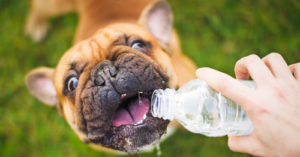
There has been a lot of talk in recent years about whether commercial dog food is safe. But what about the water we put in our best friends’ bowls?
The Flint water crisis continues to this day, and the long-term repercussions are yet to be seen. Still, many of us fill our dogs’ water bowls from the sink without a second thought. If tap water can be so dangerous for us, how can it possibly be safe for our pets?
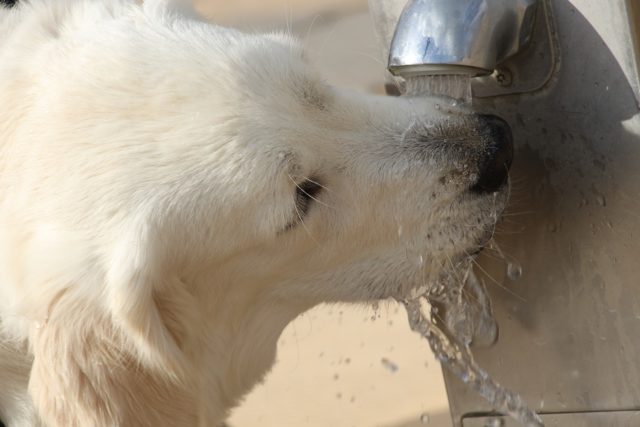
Tap Water Dangers
As many of you are probably aware, there is a LOT more in our drinking water then H20. Dr. Janice Elenbaas, Founder of Fluoride Alert and Lucky Dog Cuisine warns of the dangers of too much fluoride in our water.
What people may not realize is that the additive fluoride (used to prevent tooth decay) is synthetic.
“It is a by-product of fluoride gas, which is found commonly used in the aluminum and nuclear industries. It is a waste product of these industries and contains dangerous heavy metals,” Dr.Elenbaas explains. “Most European countries have banned the addition of fluoride to the water supply due to research that shows that fluoride ingestion causes a myriad of diseases.”
Known Flouride Effects:
- Osteosarcoma (bone cancer)
- Weakening of bones and degenerative conditions like arthritis
- Kidney disease
- Disruption of the endocrine system – affecting the thyroid, adrenals, pancreas, pineal gland and pituitary gland
- Distortion of brain cells and early dementia
- Increase in free radical production in the brain
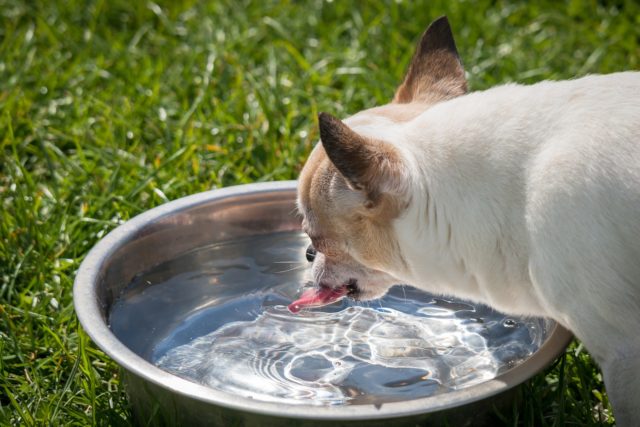
If you are thinking, well, there can’t be that much in each sip my dog drinks, so what’s the problem? The problem is, like lead, the effects are cumulative. AND IRREVERSIBLE. So, drinking a little fluoride each day CAN cause problems. And, remember, water is in EVERYTHING.
“The EPA found significant levels of fluoride in 8 major brands of dog food. The major source of contamination is found in bone meal and in animal by-products,” Dr. Elenbaas says. “An average 10 pound puppy eating about 1 cup of dog food a day would consume 5 times the safe levels set by the US Department of Health and Human Services.”
Heavy Metals & Toxins
Michael Cervin, a water expert, senior editor at BottledWaterWeb.com, and author of the book, “Our World of Water: The Good, the Bad, and The Ugly of Earth’s Most Critical Resource,” as well as a new water blog, ThisWorldofWater.blogspot.com, adds that our water contains arsenic, lead, uranium and mercury that occur naturally in our soil.
What concerns him more, are the man-made toxins, such as pesticides, herbicides, pharmaceuticals, and the aforementioned fluoride. These are the most widespread contaminants in our public water supply.
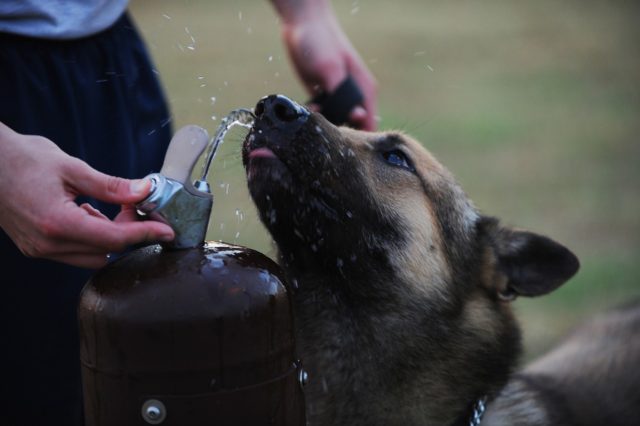
Cervin’s research has led him to the following concerning facts:
- Regarding pesticides, the Environmental Protection Agency states: “The health effects of pesticides depend on the type of pesticide. Some, such as the organophosphates and carbamates, affect the nervous system. Others may irritate the skin or eyes. Some pesticides may be carcinogens.”
- Pharmaceuticals are known to be endocrine disruptors. According to the National Institute for Environmental Health Sciences, “Endocrine disruptors are chemicals that may interfere with the body’s endocrine system and produce adverse developmental, reproductive, neurological, and immune effects in both humans and wildlife.”
- Excess fluoride is both naturally occurring and man-made. About 70% of the public water supply in America is fluoridated which affects the food supply. The Environmental Working Group has advised dog owners to, “avoid dog foods containing chicken by-product meal, poultry by-product meal, chicken meal, beef and bone meal, turkey meal and lamb meal. These ‘meals’ contain ground bone that is the source of fluoride that farmed animals accumulate.”
How Big Is The Threat?
You may not think much of it, but many of the ailments seen in humans and pets could be caused by contaminants in our water (remember Erin Brockovich?).
“Chances are the amounts of contaminants in our water aren’t all that dangerous in small doses,” explains Cervin, “but the growing amount of them in our water is. There are about 60,000 different chemicals used in the U.S. currently, yet less than 1% of those are screened for public water testing. I am concerned with lack of funding for proper testing, lack of oversight, and lack of strict regulation (more to the point it’s about enforcement) concerning public water supplies, and the vast and growing amount of toxins in our water.”
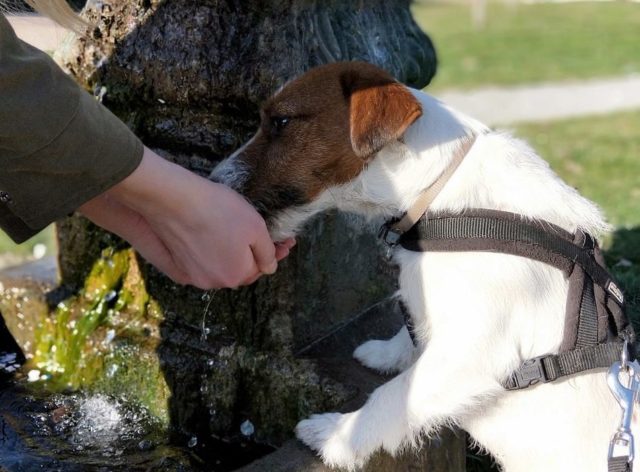
Safe Water Tips
So how do the experts suggest you keep your dog safe from water contaminants? DON’T LET THEM DRINK TAP WATER!
Dr. Elenbaas suggests using either distilled water or a reverse osmosis system. For dog foods and other times you can’t avoid fluoride-ridden water, she recommends supplementing with apple pectin, turmeric, parsley and cilantro— natural ways to detoxify and remove fluoride from the body.
What About Water Filters Like Britta or PUR Filter?
Cervin says these mass market filters are not always what they are cracked up to be.
“Many people don’t realize that basic home water filters deal with only basic contaminants, typically around 10-15 constituents, and many only reduce contaminants; they don’t necessarily remove all contaminants,” he explains. “There are some very good but expensive filters on the market that will fully (99.99%) remove certain constituents, but you need to do your research to find out which ones. Basic filters like Britta are great for making water taste better and filtering out sediments, but do little else. Other more comprehensive filters tackle more substantial contaminants.”
Cervin uses bottled water for his own dogs, and suggests others do the same.
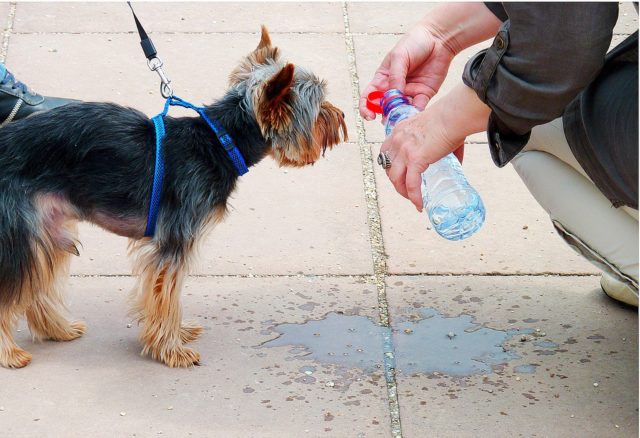
Choosing a Filter
If you decide a filter is the right choice for your family, Cervin suggests you:
“Ask for your Consumer Confidence Report/Water Quality Report from your municipal water supplier which will tell you what and how much of something is in your tap water. Then use that information to tailor a home filter for you. It’s important to purchase a filter that is NSF certified, and not be brand loyal.”
He also notes that if you hike or camp with your dog and they are often playing and/or drinking in rivers, lakes, and streams, you may want to get a portable filter that screens for giardia and cryptosporidium (bacteria from fecal matter often found in rivers and streams).
The post Is The Water Your Dog Drinks Safe? appeared first on iHeartDogs.com.
via Whisker Therapy